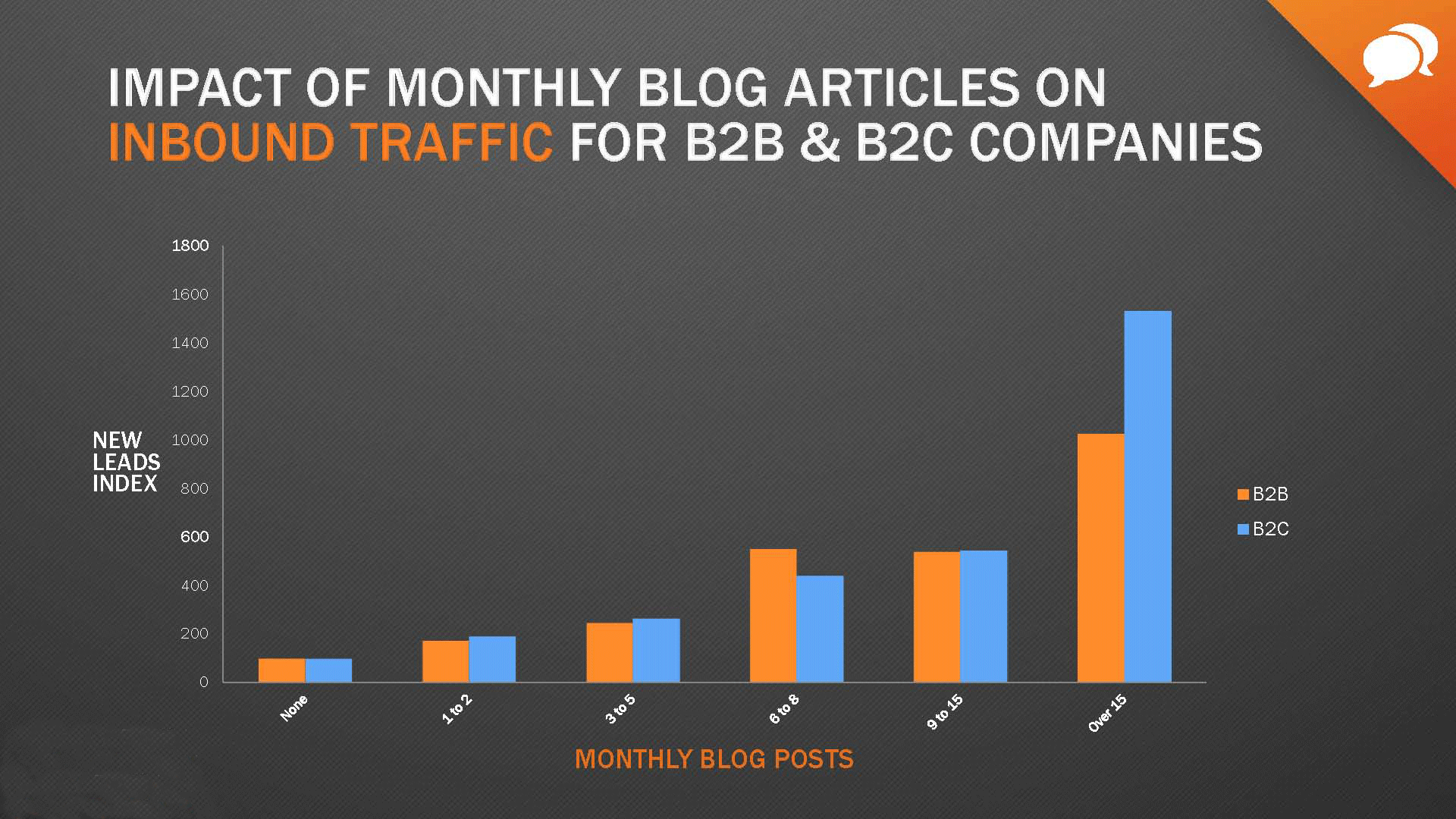Marketing KPIs & Benchmarks for 2026
We work with B2B leaders every day who have extensive marketing data, but don't know what to make of it. It's hard to know you're on track to meet...

There has been considerable buzz lately about the importance of creating quality content as a way to attract and qualify online sales leads. The idea is that through online engagement, in which you share best practices and tips for your particular expertise, for example, you attract higher quality leads. But what kinds of content are considered “quality”, and is more necessarily better?
Here are some content questions to get you on the right track:
So you want to start a company blog, or maybe you already have one and want to start posting more frequently. How do you come up with compelling content on a regular basis? “Writing a useful, popular blog doesn't require that you come up with spellbinding new ideas every day,” reveals Hubspot contributor Rick Burnes. Rather than racking your brain for new concepts, pay attention to your surroundings and find inspiration in the daily goings-on of your business.
Your company is in business for a reason, so why not let people know that reason? Figure out what insight can you offer that is different or better than everyone else’s, and share it. Burnes recommends publishing any unique data that your company collects. Analyses of either your own data or data from another source are also helpful. It’s easy to spout off numbers but harder to assess what they really mean; people will appreciate you sorting it out for them.
Tips and Best Practices are usually popular blog posts. People are busy, and they like cheat sheets and lists from which they can quickly reference answers. However, people will also go for a good story. Anecdotes of how your business solved Problems X and Y or helped Customer Z are useful for a couple of reasons: a) They offer concrete examples of your success (and proof of your expertise); and b) They can be written in a more literary or playful style, which is a welcome relief from data and cut-and-dried directives.
The customer feature is also a fairly easy and beneficial piece of content. You can interview a customer and write the blog in Q and A format, with general questions such as “What does [CustomerCompany] do?” to more specific ones such as “What problem was [CustomerCompany] having?” and “How was [YourCompany] able to help?” Or you can write the feature in a more anecdotal form, as mentioned above – and an especially happy customer might be willing to write about their experience themself. What better way to show the value of your brand than telling the tale of the person whose business you saved? Not only is the story a great testimonial to other potential customers, but it also shows the featured customer that you value their business, making them even more loyal to your brand (you know, if the business-saving thing wasn’t enough to hold ‘em.) The customer feature is a best practice for social media, too. If one of your customers is making strides in research or launching a new product, retweet or mention them on Twitter, or devote a post to them on Facebook. Even if said accomplishment doesn’t directly relate to something your business did, the customer will still appreciate the acknowledgement.
Just as you hope your blog posts will prompt conversation with customers, discussion can likewise bring about informative blog posts. If someone asks a question in a forum, online comment, email, or even in person that merits a detailed answer, Burnes suggests turning that Q and A into a post. Not only is the response something you would have written anyway (yea for customer engagement!), but the question is likely something other customers or prospects are also wondering about.
Second, never underestimate the power of a good guest post or interview-with-an-expert. Yes, you want to highlight your own know-how, but it also looks good to know other people who know a lot. Sharing advice from industry leaders shows that you are committed to offering your customers top-notch industry information, and that you know where to find it. Burnes suggests that you keep an eye on Twitter to find out when interesting people will be visiting your area.
Great content is nothing if no one reads it. After you write and post your blog entry, the next step is promoting it through social media. Tweet the shortened link with a snappy, attention-grabbing headline (not necessarily the actual title of the post) or an interesting fact from the post. Also share the link on Facebook and Google+ if you have one; here you can include a brief description of the blog post, an interesting fact or a compelling quote.
Google+ Circles and LinkedIn Groups can also be useful for promoting content to more targeted audiences; if PLS has a blog post or other article we want to share that is related to a certain industry, we can post it to a trade-specific Group where the information will likely be better-received.
It is also helpful to pay attention to when more of your followers are actually online and post then so your content doesn’t get lost in the newsfeed shuffle.
If a certain post is not time-sensitive, meaning it contains general information that is continuously relevant, you can link to it from a page elsewhere on your website that has related content. And if you are serious about this blogging thing, you should also have a link to your general blog displayed prominently on your home page, as well as in the description section of your social media profiles.
Writing a blog post is a lot like developing a new product or starting a new business: You must know the questions before you can come up with the answers. It is important to think about what problem your post is addressing – and hopefully solving – for the customer. There are various types of issues a post can cover:
Deciding what problems to address requires a thorough knowledge of your target audience. Hubspot recommends creating buyer personas to determine exactly what “pain points” or problems your readers will need you to tackle. Once you’ve uncovered this, HubSpot says, “ask yourself whether the piece of content you're creating addresses an aspect of those pain points.”
So now you are sure you’ve hit those pain points and are confident people will read your blog – awesome! But you’re not done. Reading might spark their interest in your business, but it won’t necessarily motivate them to do anything about it. A call to action, whether a link to download an eBook or a simple request to “tweet this post,” is an easy addition that can make a huge difference in your ability to attain and engage customers. “If you have 10 readers who read your post but don't react, you'll reach 10 people. If you have 10 readers who post your article on Twitter where they're followed by 100 people, you'll reach 1,000 people,” Burnes notes.
Just make sure these CTAs are subtle enough that they don’t drown out valuable content. “Business blogs are marketing tools and need to drive sales,” Burnes writes. “Yet in order to do that, they need to provide quality content without a sales pitch. Every business blogger needs to find the right balance on their own.”
The old mantra “Reduce, Reuse, and Recycle” ain’t just for tin cans and newspaper anymore; in fact it can be applied to digital content. Different channels, i.e., different social networks, lend themselves to different types of content, and vice versa. If you think a particular post will drum up differing opinions or ideas, create a Facebook or Google+ poll based on it. If a subject would be better explained visually, create an infographic, slide show, or video to supplement the blog. Videos in particular are a great way to demonstrate how products work, or to highlight the people behind the products. If you already have a blog post listing tips or a step-by-step process, why not turn it into a downloadable checklist or eBook?
Repurposing content is a two-way street. Already have a video or slide show? These can be substituted as blog posts, either by themselves or accompanied by a more detailed text explanation. Describe the “making of” or “behind the scenes” of the video. Share a video that was already posted on your YouTube and include the best comments or answer questions in the blog post. Burnes suggests using a blog post to refine your talking points for a presentation or conference.
There is some debate over whether more is really better when it comes to blogging and posting on social media. Although its research shows that posting more frequently improves the effectiveness of online content, HubSpot still recommends focusing on quality over quantity: “If you’re trying to compensate for low or even mediocre quality with high quantity, you’re doing yourself more harm than good. Readers won’t regard your content well, and as a result, Google won’t hold your domain in high regard, either.”
HubSpot’s blogging frequency “sweet spot” for B2B companies is 6-8 times a month. If you don't think you can commit to 1 post per week, don’t sweat it; HubSpot’s data suggests only minor impact on lead generation compared to posting monthly. However, if you are aiming for a greater impact, commit to posting 2 times per week for 12 months – that’s 104 posts per year. Revisit at 6 months. It is easier to adjust down than to ramp up. You might want to create a 2 or 3 weeks back log of posts to start with.

Graph courtesy HubSpot.com.
Many businesses also fear crossing the line between getting noticed and clogging people’s newsfeeds to the point getting un-followed. However, Silver Square, Inc. explains that it can be advantageous to reuse content if you vary the medium and message: “Posting updates multiple times in various channels allows you to maximize your content and catch more individuals through various phrases that may resonate more than others, a platform that reaches more than others or a search result that pulls in more search results than your company URL – and they all lead back to your website and original flagship content.”

We work with B2B leaders every day who have extensive marketing data, but don't know what to make of it. It's hard to know you're on track to meet...

Get a Competitive Edge with Comprehensive AI & GEO Insights If you are beginning to notice an erosion in organic traffic and leads, it may be time to...

Updated on 6/10/24 The 80/20 rule or Pareto principle, is a long-standing business strategy that a lot of companies are applying right now to...